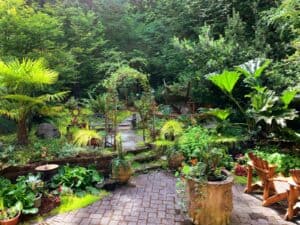Imagine stepping into a space where the hustle of daily life fades away, replaced by the soothing whispers of nature—welcome to the world of meditative gardening. This practice isn’t just about beautifying your outdoor space; it’s an invitation to forge a deeper connection with yourself and the serene rhythms of nature. A meditation garden offers you a sanctuary where peace and mindfulness flourish.
By integrating simple elements of nature, you can transform any garden area into a dedicated zone for meditation and reflection. Whether you’re crafting a new garden from scratch or reimagining a corner of your backyard, meditative gardening is about creating a space that resonates with tranquility and invites you to pause and rejuvenate.
Dive into the philosophy and practical tips for establishing your own meditative garden. Discover how this peaceful pursuit can not only enhance your outdoor environment but also enrich your inner life, providing a quiet retreat to unwind and refocus in today’s fast-paced world.
What Is Meditative Gardening?

Meditative gardening involves engaging in garden activities with a mindfulness approach. It blends the physical acts of gardening—such as planting, weeding, and watering—with mental health practices centered around meditation and mindfulness. The goal is to create a two-hour escape where you nurture plants and your inner self, fostering a peaceful interaction with the natural world.
In your own meditation garden, you attain relaxation through gardening by focusing on the moment, breathing deeply, and observing the sensations of the earth and plants around you. Whether it involves sitting quietly on a small bench amidst your garden or walking gently through green space, meditative gardening allows you to practice mindfulness, enhancing both mental and physical well-being. This quiet, structured practice reduces stress, lowers blood pressure, and improves your mood and attention span.
Creating a meditation garden doesn’t require vast tracts of land; even a modest backyard or a quiet corner with simple elements like flowers, wind chimes, or a bird feeder can transform into a meditative retreat. It’s about finding little ways to connect deeper with nature and allowing yourself the space and time to focus, relax, and meditate in the serenity of your surroundings. This practice is not just about nurturing your garden, but also about nurturing a state of calm and tranquility within yourself.
History and Evolution of Meditative Gardening
Meditative gardening dates back to ancient times, serving as a profound way to cultivate tranquility and mindfulness through the simple act of tending a garden. Initially nurtured by the Persians around 500 to 300 BCE, these gardens were not just for beauty or food production but also spaces meant for reflection and soulful connection. Persian gardens emphasized balance, symmetry, and geometric design, elements that reflect the meditative practices aimed at creating harmony and peace.
Between 226 and 641, the concept evolved further as gardens began incorporating elaborate mandala designs. These designs were deeply spiritual and symbolic, encouraging gardeners to meditate as they walked the paths and tended to plants. This historical blending of nature and mindfulness laid the groundwork for what you recognize today as meditative gardening.
In modern times, meditative gardening continues to flourish, emphasizing the relationship between natural elements and mental health. When you step into your garden, you engage in a deliberate, mindful process that can lower blood pressure, soothe your eyes, and reduce anxiety. This practice of being present as you dig, plant, and nurture not only benefits your garden but significantly enhances your overall well-being by providing a peaceful retreat from daily life.
Benefits of Meditative Gardening

Physical Benefits
Engaging in meditative gardening not only connects you with the natural world but also offers substantial physical benefits. Regular garden meditation can lead to lower blood pressure and reduced inflammation, creating a healthier body environment. Gardening requires physical activity that varies from light to moderate, which helps to increase blood circulation and enhance muscle strength. If you spend a minimum of two hours a week tending to your garden, you might notice an improvement in your overall physical health. This practice serves as a form of mild exercise that can help manage body weight and contribute to a healthier lifestyle. Moreover, the act of planting and nurturing can improve hand dexterity and coordination.
Mental and Emotional Benefits
Meditative gardening allows you to focus on the present moment, which helps to clear your mind and reduce stress levels. It’s a therapeutic activity that offers a chance for mindfulness and reflection, leading to enhanced mental and emotional well-being. This form of gardening encourages you to practice mindfulness by deeply engaging with the environment—whether you’re feeling the soil in your hands, listening to the birds, or smelling the flowers. Regular engagement in these activities has been shown to decrease symptoms of anxiety and depression, providing you with a sense of tranquility and peace. Additionally, the satisfaction of seeing your garden thrive can boost your mood and self-esteem, fostering a closer connection to both nature and your own inner self.
Essential Elements of a Meditation Garden
Designing for Serenity: Layout and Plant Choices
When creating your own meditation garden, consider the layout and plant selection critical to fostering tranquility and presence in the moment. Opt for a design that minimizes clutter, enabling a clear path for walking and meditation. Meandering pathways, for example, encourage a slow pace and mindfulness as you move through the garden. Plant choices also play a decisive role; select species that appeal to the senses yet require minimal maintenance. Fragrant plants like lavender and jasmine can enhance relaxation, while the soft textures of moss or ferns underfoot add a comforting touch. Always ensure the plants suit your local climate, reducing the need for intensive care.
Integrating Natural Elements: Water, Stone, and Wind
Incorporating natural elements such as water, stone, and wind into your meditation garden not only enhances the beauty of the space but also helps connect you with nature’s deeper elements. A small water feature, like a fountain or a bird bath, adds a soothing backdrop of sound that can aid in deepening your meditation practice. Stones and boulders can serve both aesthetic and practical functions; they provide structure to your garden and can be used as seating or focal points for meditation. Wind chimes or bamboo rustlers add a gentle, melodious sound that stirs with the breeze, heightening your garden’s sensory experience and assisting in achieving mindfulness and calm.
Techniques for Mindful Gardening

Engaging the Senses
To enhance your meditative gardening experience, engaging all your senses can transform a simple garden into a sanctuary of mindfulness. Start by selecting plants that not only look beautiful but also emit soothing fragrances. Lavender and jasmine are popular choices that add a layer of aromatherapy to your garden space. Incorporate elements that appeal to your sense of sound, such as wind chimes or a small water feature. The gentle clinking and the soothing sound of flowing water can significantly deepen your connection to the present moment.
Including various textures in your garden can also stimulate your sense of touch. Think about adding plants like lamb’s ear, which feature soft, velvety leaves, or ornamental grasses that sway and rustle in the breeze. For taste, consider planting herbs or edible flowers like chamomile or nasturtiums. You can use these directly from your garden during a break as you meditate or tend to your plants, enhancing the experience of relaxation through gardening.
Mindful Movement in the Garden
Meditative gardening isn’t just about sitting quietly; it involves mindful movement. As you walk slowly through your garden, focus on each step, and feel the ground beneath your feet. Practice grounding techniques by literally feeling the earth, like soil or grass, with your hands or bare feet. This act of connecting physically with earth can improve your mindfulness and attention span.
Moreover, deliberate, slow movements such as bending to plant or prune, or walking a labyrinth made from garden pathways, encourage a meditative state. These activities allow you to focus on your body’s movements in relation to the natural world around you, helping you achieve a flow state. Remember, each action in the garden, from watering plants to digging the soil, is an opportunity to practice mindfulness. By concentrating on these repetitive tasks, you can foster tranquility and a closer connection with nature, enhancing both your mental and physical well-being.
Creating Your Own Meditation Garden
Planning and Planting
Designing your own meditation garden offers a unique opportunity to create a tranquil retreat tailored to your personal sense of peace and beauty. Begin by selecting a spot in your garden that feels natural for solitude and reflection, ideally one that minimizes distractions from the outside world. When planning, consider the path of the sun through your garden and choose a location that matches your preference for sunlight or shade during your meditative time.
The choice of plants plays a pivotal role in fostering relaxation and mindfulness. Opt for native plants that thrive with minimal intervention, maintaining the garden’s sustainability and easing your workload. Incorporate elements like small benches or a clearly defined pathway to encourage slow, mindful walking or sitting. Plants like lavender, jasmine, or mint not only add beauty and texture but also stimulate the senses with their soothing scents, enhancing the calming atmosphere.
Maintaining Mindfulness in Garden Upkeep
As your meditation garden evolves, the practice of maintaining it should also serve as a meditative activity rather than a chore. Dedicate time to regular, mindful interactions with your garden, whether you’re weeding, pruning, or simply observing changes in the plants and wildlife. These activities provide a perfect moment to practice mindfulness, keeping you fully present and engaged with the task at hand.
Develop a routine that allows you to tend to the garden at times that contribute to your sense of tranquility, such as early mornings or late afternoons. This routine not only helps in sustaining the garden’s health but also ensures that you routinely reconnect with nature and your meditative space. As you engage in garden upkeep, embrace each movement and breath, allowing the simplicity of the task to enhance your focus and deepen your connection to the natural world.
Wrapping Up
Embracing meditative gardening transforms your outdoor space into a sanctuary that not only beautifies your environment but also enriches your mental and physical health. By integrating sensory elements and practicing mindfulness, you create a deeply personal retreat that fosters tranquility and connection with nature. Whether you’re pruning your plants or simply enjoying the serenity of your garden, each moment spent is a step towards a more mindful and healthier lifestyle. Let your garden be a reflection of your journey towards inner peace and well-being.
Other suggested articles:

